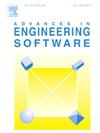利用 GPU 加速和 LTS/GMaTS 混合方法建立面向工程的浅水水文沉积-形态动力学模型
IF 4
2区 工程技术
Q2 COMPUTER SCIENCE, INTERDISCIPLINARY APPLICATIONS
引用次数: 0
摘要
有限体积浅水水文-沉积-形态动力学模型(SHSM)的工程应用面临着诸多限制,原因是其计算需求很高,要么是计算单元数量极大,要么是某些区域的时间步长极小,同时还采用了全局最小时间步长。为此,我们提出了一个面向工程的建模框架:(1) 使用 GPU 加速,克服了计算单元量极大的挑战;(2) 使用局部时间步长/全局最大时间步长(LTS/GMaTS)混合策略,缓解了因局部细化网格或流动条件不均匀而导致的局部时间步长极小的问题。为充分利用 GPU 的计算能力,我们对 GPU 并行算法进行了定制,优化了数值结构、内核函数和内存使用,所有这些都与 LTS/GMaTS 混合实现相结合。我们通过模拟长江中游新九水道的一次试验性断坝流和一个野外尺度的案例,证明了该方案的计算效率。结果表明,该方案在再现真实世界水文沉积物形态演变方面具有良好的精度、效率和鲁棒性。本文章由计算机程序翻译,如有差异,请以英文原文为准。
An engineering-oriented Shallow-water Hydro-Sediment-Morphodynamic model using the GPU-acceleration and the hybrid LTS/GMaTS method
Engineering applications of finite volume Shallow-water Hydro-Sediment-Morphodynamic models (SHSM) have faced limitations due to their high computational demands arising from either extremely large amounts of computational cells or extremely small time steps at some regions and simultaneously the adoption of the globally minimum time step. To this end, we present an engineering-oriented modeling framework by (1) using the GPU-acceleration that overcomes the challenge of extremely large amounts of computational cells and (2) using a hybrid local-time-stepping/global maximum time step (LTS/GMaTS) strategy that mitigates the extremely small local time steps necessitated by locally-refined meshes or non-uniformity of flow conditions. The GPU parallel algorithm is tailored to fully leverage the computational power of GPU, optimizing numerical structure, kernel functions and memory usage, all in conjunction with the hybrid LTS/GMaTS implementation. We demonstrate its computational efficiency by simulating one experimental dam-break flow and a field-scale case in the Xinjiu waterway, Middle Yangtze River. The results show that the scheme performs well in terms of accuracy, efficiency, and robustness in reproducing real-world hydro-sediment-morphological evolution.
求助全文
通过发布文献求助,成功后即可免费获取论文全文。
去求助
来源期刊

Advances in Engineering Software
工程技术-计算机:跨学科应用
CiteScore
7.70
自引率
4.20%
发文量
169
审稿时长
37 days
期刊介绍:
The objective of this journal is to communicate recent and projected advances in computer-based engineering techniques. The fields covered include mechanical, aerospace, civil and environmental engineering, with an emphasis on research and development leading to practical problem-solving.
The scope of the journal includes:
• Innovative computational strategies and numerical algorithms for large-scale engineering problems
• Analysis and simulation techniques and systems
• Model and mesh generation
• Control of the accuracy, stability and efficiency of computational process
• Exploitation of new computing environments (eg distributed hetergeneous and collaborative computing)
• Advanced visualization techniques, virtual environments and prototyping
• Applications of AI, knowledge-based systems, computational intelligence, including fuzzy logic, neural networks and evolutionary computations
• Application of object-oriented technology to engineering problems
• Intelligent human computer interfaces
• Design automation, multidisciplinary design and optimization
• CAD, CAE and integrated process and product development systems
• Quality and reliability.
 求助内容:
求助内容: 应助结果提醒方式:
应助结果提醒方式:


